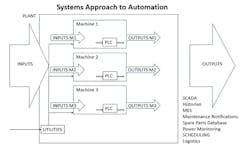What does factory modularity mean for machine controls?
Modularity is a popular term today in automation and machine building. How can you apply modularity to your design? If a machine is broken up into systems, not just on functionality but on resource, then it may be seen a little more easily.
What do control systems have? Power, pneumatics, motion, communications, alarms, MES feedback and SCADA setup, for example.
Get your subscription to Control Design’s daily newsletter.
What if we picture not just the functionality of the line broken into systems and subsystems, but the support of the line—can you modularize utilities? Do you have premade code that you can use for monitoring and controlling power or air or water?
Then we modularize the functionality—some kind of prep work to the material, do something to the material and then output the material. The idea of using open programmable logic controllers (PLCs) and creating applications for these things rings loud. Why? If you handle utilities the same way for every machine build, then you may have templated code and a templated hardware configuration.
Take it one step forward as an input to an application. This would be the advantage of C/C++ or the like. As a system, controls involve sensor, controller, and actuator. Think of these as symbolic terms:
- sensor (inputs): field devices and feedback of some kind of measurement
- controller (factory/plant): converts signals from the field and decides on an outcome
- actuator (outputs): the actuator symbolizes the output side and motion. For discrete systems this is linear or rotary motion. For process control, motion is still involved in motor/pump control or actuation of valves.
Substituting the plant/PLC for controller allows the plant to be seen as a system itself. Then everything inside the plant is a subsystem to the plant. This means, from a data perspective, the sky is the limit for applications.
Let us take a different look. Remember in the 1960s, when there were hundreds of relays they wanted to put into a box and make it easier, smarter, simpler? The same thing is occurring now with the push for edge computing, Industrial Internet of Things (IIoT) and Industry 4.0. The difference is that manufacturers have hundreds of data silos, and the drive is to apply artificial intelligence and machine learning, instead of computers.
This push will change the PLC and the way that we look at PLC-oriented control systems. Eventually, the PLC will become a smaller entity as instrumentation is controlled by computers remotely. Unified namespace applied technology fits with systems-oriented ideas and being able to repeat subsystems in the system and to document additions of hardware in the system as they are added.
This is the drive behind the Clean Energy Smart Manufacturing Innovation Institute (CESMII), which is working to tie data silos together in manufacturing and progress Industry 4.0 initiatives to enhance the digital transformation.
This way of thinking has been dubbed “smart factory.” The current roadblocks with the smart factory are high initial investment, cybersecurity risks, organizational complexity, skilled personnel and competition for resources. There is not an application for it. The solution is long-term and will only be successful for turning manufacturing, if there are long-term commitments to embracing and maintaining new technology.
About the Author
Tobey Strauch
Arconic Davenport
Tobey Strauch is currently managing brownfield installations for controls upgrades at Arconic Davenport. She has previously worked as principal controls engineer and before getting her bachelor’s in electrical engineering, was a telecommunications network technician. She has 20 plus years in automation and controls. She has commissioned systems, programmed PLCs and robots, and SCADAs, as well as managed maintenance crews. She has a broad mix of mechatronics with process control. She enjoys solving problems with Matlab and Simscape. Contact her at [email protected].

Leaders relevant to this article:

